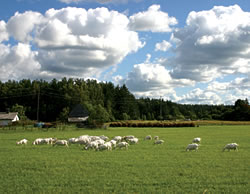BUSINESS
Inside SCV History
An Unlikely Combination of Oil and Sheep Help Solve Great Depression Woes
July, 2006 - Issue #21
 |
The first of these experiments was recommended by Joseph McGrath, who was effectively doing the same in Oxnard that the Newhall Company was doing in Rancho San Fernando (though the name was changed to Newhall Ranch in the 1930s, before becoming the Santa Clarita Valley much later). McGrath, whose ranches had begun with sheep farming, recommended the same for Newhall Ranch. So, 70 years ago, 25,000 head of sheep roamed the area now zoned as the Valencia Industrial Center.
The flocks were managed by another victim of the Great Depression. Like so many other "Okies," the Gallion family came West from Missouri in the midst of the Depression after poverty, sandstorms and a horrible harvest laid ruin to the Midwest. Originally starting as an irrigation worker utterly unfamiliar to anyone, Dee Gallion worked his way up in the Newhall Farm organization. With the introduction of sheep to the Newhall lands, Dee was assigned to manage the entire flock and the herders. His employment with the company and his love for this beautiful valley were the driving force behind his long tenure here. After moving from Missouri, Dee would live the next 52 years of his life on Newhall lands.
Sheep were not the only source of new revenue for the farm, however. In 1935, Atholl, the company president, suggested that if things continued to recover nicely, stockholder dividends could begin as soon as the following year. For the Newhall family, who had nearly their entire fortune invested in the company, this was welcome news as the suspension of stockholder payments had abruptly ended their extravagant lifestyle.
| "It now seemed as though the entire Newhall property lay on top of a vast oil deposit. Seemingly no matter where they were situated, wells struck black gold." |
This changed the following year when Barnsdall Oil Company leased land for oil exploration. For 12.5 percent royalties, the Newhall Land and Farming Company became partners in the exploration. Though attempts were made to purchase these royalty rights, McBean, with the guidance of his directors, maintained control. In December 1936, more than a mile below the surface, Barnsdall struck black gold. Over the next 15 years, numerous other successful wells covered the southern and western portions of the valley. After seeing the possibilities for further revenue, Atholl assigned James Finch, his management expert, to negotiate all further oil exploration on the property.
The board and stockholders couldn't have been happier with the new profits. Contrary to McBean's assessment a decade earlier, it now seemed as though the entire Newhall property lay on top of a vast oil deposit. Seemingly no matter where they were situated, wells struck the treasure. Wells went as deep as three miles, then the deepest producing well in the world.
After the war, new technology and machinery allowed for the pressurization of the wells, increasing production and efficiency by 50 percent. Profits and stockholder confidence soared as the nation emerged from the Great Depression.
--------------------------------------------------------------
Much of the research from this article came from "A California Legend: The Newhall Land and Farming Company" by Ruth Waldo Newhall.
|
||||||||||||||||||||||||||||




